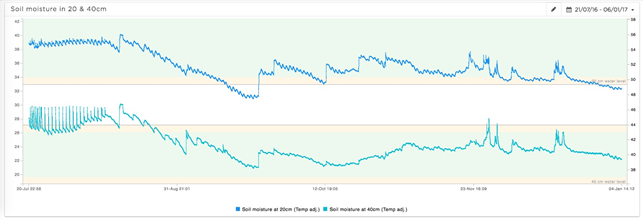Soil moisture sensors: are you using the right one?
15 Jan 2019
What’s the soil moisture in your fields right now?
If you can’t say for sure, you may be using the wrong measuring tools.
If you can’t say for sure, you may be using the wrong measuring tools.
Soil moisture is the single most important parameter of your farming activity. Too little water and your crops will suffer drought. Too much water will cause hydric stress, soil and fertiliser erosion, not to mention the waste of money and a precious resource. Either way, your yields will be lower than they could be.
How much water is available to crops depends on many things:
- rainfall
- soil texture
- topography
- soil depth
- content of organic matter
- biological activity
- evapotranspiration
- how much water roots absorb
- how much water is available at roots depth
- how much you irrigated
This long list is precisely why farmers need to use accurate tools to measure soil moisture and make informed decisions. Experience and guesswork alone won’t do.
The most common types of soil moisture sensors
There are several types of soil moisture sensors. In your farming business you're probably using one of these three.Solid state sensors, also known as resistive sensors, consist of two electrodes with a flow of electric current between them. The readout will depend on the amount of resistance between the two poles: water is an efficient conductor, so the more humid the soil, the less the resistance and vice versa.
Resistive sensors are affordable and easy to use. Their lifespan, however, can be a problem. They operate in a hostile environment, so over time humidity and the effects of electrolysis will eventually corrode the electrodes, leading to false readouts.
A tensiometer is a sealed tube with a porous tip on one end. Inside it’s partly filled with water and partly by vacuum. The measuring principle is based on osmotic balance: with high humidity, water will enter the tube thereby decreasing the vacuum inside; in a drier environment, the soil will pull water out of the tube, increasing the vacuum. The final readout will depend on the changes of pressure inside the tube.
Tensiometers are also very affordable and last longer than resistive sensors. The problem with them is that readouts are often influenced by factors other than humidity: temperature, the type of soil, or the presence of rocks or other objects. On top of that, converting pressure into measurable soil moisture won’t always be straightforward. Farmers will often have to use tables to do that, and manual calculations are the enemy of accuracy.
The most common type are capacitive sensors. They consist of two plates fed with a frequency that resonates with water, creating an electromagnetic sphere that protrudes beyond the surface of the sensor. Because the frequency is affected mainly by water, with capacitive sensors farmers get high sampling accuracy and more accurate readouts. Also, they last longer: although the plates are buried in the soil, they don't need to be in direct contact with it.
Our simple capacitive sensing solution
One thing that all soil moisture sensors have in common, is that data can be difficult to read and interpret and that includes capacitive sensors. However, once users are past the learning curve, higher data accuracy immediately shows its benefits.Here below is an example of how our capacitive sensors solution saved our customer 6x on water, electricity for pumping water and a lot of fungicides and pesticides.

The first graph represents soil moisture values at 20cm deep while the bottom graph represents values at 40cm.
The peaks on the left-side of the charts are irrigation events during the first week. In that initial period, the customer irrigated as usual. However, values were constantly above the green band, showing that crops were getting too much water.
Following our recommendation, the customer decided (although a bit skeptical at first) to reduce irrigation time. That’s when peaks stayed within the optimal moisture range.
Thanks to the data above, our customer could irrigate once every three days, instead of twice daily, and that meant saving a lot on water and electricity. Also, he reported that he didn’t need to use fungicides for the new season and that the quality and quantity of his harvest was much better than in previous years.









